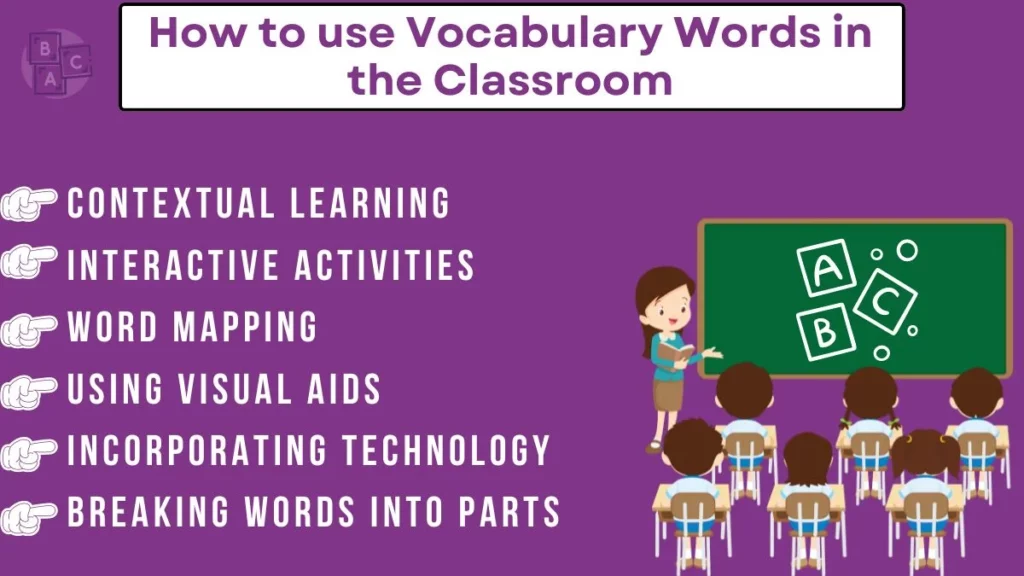Vocabulary is a key part of learning. It helps students understand what they read and say. In classrooms, teaching vocabulary helps improve communication and reading skills. This article will share ways to teach vocabulary effectively in the school.

Strategies for Teaching Vocabulary
The following are the best strategies for using Vocabulary Words in the Classroom:
1. Contextual Learning
One of the best ways to teach new words is by using them in context. This means showing how words are used in sentences, stories, or discussions. When students hear new words in a sentence, they understand them better.
Activity example: Read a story and ask students to find the new words. Then discuss what each word means in the sentence. This helps students guess the word’s meaning based on how it is used.
2. Interactive Activities
Interactive activities make learning fun and help students remember new words. Games like vocabulary charades, word walls, or bingo are great for this. These games involve students, making them think about and use the words.
Benefits of group activities: Students learn from each other When they play games or work in groups. They also feel more confident using new words because they practice in a relaxed setting.
3. Word Mapping
Word maps are visual tools that help students explore a word deeply. A word map shows a word, its meaning, synonyms, antonyms, and examples of how to use it.
How to create a word map: Write the new word in the center of the map. Then, draw lines to connect it to other details like its definition, a sentence using the word, and similar or opposite words.
Example: For the word “analyze,” the map could include:
- Definition: To examine something closely.
- Synonym: Examine, study.
- Antonym: Ignore.
- Sentence: “We need to analyze the data.”
4. Incorporating Technology
Technology can make vocabulary learning more engaging. There are many apps and websites like Quizlet that let students practice new words. These tools are fun and interactive. It helps students review vocabulary through games, quizzes, and flashcards.
Personalized learning: Apps can track a student’s progress and focus on the words they need more practice with. This helps students learn at their own pace.
5. Regular Review and Assessment
Reviewing vocabulary words regularly is important for long-term learning. It helps students remember words and use them confidently.
Review methods: Teachers can review words through quick quizzes, creative writing assignments, or even group discussions. This keeps the words fresh in students’ minds.
Assessment ideas: Have students use new words in sentences or short stories. Another way is to give them a list of words and ask them to match each word to its meaning.
6. Using Visual Aids
Visual aids, like pictures, diagrams, and videos, can help students connect words with images. This is especially useful for younger students or visual learners. When students see a word along with an image, they are more likely to remember it.
Example: If teaching the word “volcano,” show a picture or video of a volcano erupting. This helps students understand the meaning of the word by linking it to something they can see.
Activity: Create flashcards with the word on one side and a picture on the other. Use these for quick review games in the classroom.
7. Storytelling and Role Play
Storytelling allows students to see how vocabulary words are used in real situations. You can create stories that include the new words you’re teaching. Role-play also allows students to act out words in different scenarios. It makes learning more interactive and memorable.
Example: When teaching the word “persuade,” create a short skit where one student tries to persuade another to share their lunch. This shows students how the word is used in a conversation.
8. Breaking Words Into Parts
Teach students how to break down complex words into smaller parts, like prefixes, suffixes, and root words. Understanding these parts helps students figure out the meanings of new words. Even if they’ve never seen the word before.
Example: For the word “unbelievable,” explain that “un-” means “not,” “believe” is the root, and “-able” means “able to.” This helps students understand that “unbelievable” means “not able to believe.”
Activity: Create a list of common prefixes and suffixes and have students break down words from their reading or lessons.
9. Word Journals
Encouraging students to keep word journals can help them take ownership of their vocabulary learning. In a word journal, students can write down new words they encounter, along with their definitions, example sentences, and any drawings or connections they make.
Benefit: Word journals help students engage with vocabulary more deeply by encouraging them to reflect on how they use the words in different contexts.
Activity: At the end of each week, ask students to share some of their new words and how they used them in real life.
10. Using Vocabulary in Writing Assignments
Encouraging students to use new vocabulary words in their writing helps reinforce the meaning and usage of the words. Whether through essays, creative writing, or journal entries, writing assignments give students a chance to practice vocabulary in context.
Example: After teaching new vocabulary words, ask students to write a short story or paragraph using at least five of the words.
